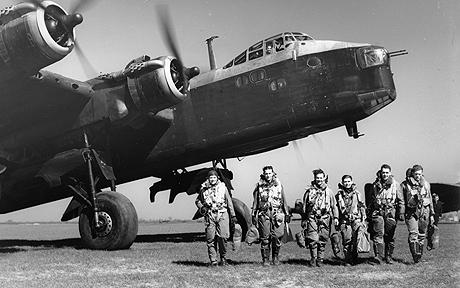The 300 Sqdn left from Hemswell at 1943-06-21 at 10:17
He flew with a Vickers Wellington (type X, serial HF591, code BH-).
Campaign report of the USAAF:
No report
Campaign report of the RAF:
20/21 June 1943
60 Lancasters to attack the Zeppelin works at Friedrichshafen, on the shores of Lake Constance (the Bodensee). This factory made Würzburg radar sets which were an important part of the German-fighter interception boxes through which Bomber Command had to fly every time they attacked a target in Germany.
This was a special raid with interesting and novel tactics. Like the recent Dams Raid, the attack was to be 'controlled' by the pilot of one of the Lancasters. This feature would later be known as 'the Master Bomber' technique. The plan was formulated by No 5 Group which provided the Master Bomber - Group Captain LC Slee - and nearly all of the aircraft involved; the Pathfinders sent 4 Lancasters of 97 Squadron. Group Captain Slee's aircraft developed engine trouble and he handed over to his deputy, Wing Commander GL Gomm of 467 Squadron. The attack, like the recent raid on Le Creusot, was intended to be carried out from 5,000 to 10,000ft in bright moonlight, but the flak and searchlight defences were very active and Wing Commander Gomm ordered the bombing force to climb a further 5,000 ft. Unfortunately the wind at the new height was stronger than anticipated and this caused difficulties.
The bombing was in 2 parts. The first bombs were aimed at target indicators dropped by one of the Pathfinder aircraft. The second phase was a 'time-and-distance' bombing run from a point on the shores of the lake to the estimated position of the factory. This was a technique which No 5 Group was developing. Photographic reconnaissance showed that nearly 10 per cent of the bombs hit the small factory and that much damage was caused there. Nearby factories were also hit.
The bomber force confused the German night fighters waiting for the return over France by flying on in the first shuttle raid to North Africa. No Lancasters were lost.
4 Mosquitos to Berlin and 1 to Düsseldorf, 15 aircraft minelaying off La Pallice and in the River Gironde. 3 OTU sorties. No losses.
21/22 June 1943
705 aircraft - 262 Lancasters, 209 Halifaxes, 117 Stirlings, 105 Wellingtons, 12 Mosquitos. 44 aircraft - to Krefeld. 17 Halifaxes, 9 Lancasters, 9 Wellingtons, 9 Stirlings - were lost, 6.2 per cent of the force. This raid was carried out before the moon period was over and the heavy casualties were mostly caused by night fighters. 12 of the aircraft lost were from the Pathfinders; 35 Squadron lost 6 out of its 19 Halifaxes taking part in the raid. The raid took place in good visibility and the Pathfinders produced an almost perfect marking effort, ground-markers dropped by Oboe Mosquitos being well backed up by the Pathfinder heavies. 619 aircraft bombed these markers, more than three quarters of them achieving bombing photographs within 3 miles of the centre of the target. A large area of fire became established and this raged, out of control, for several hours.
1 Mosquito to Hamborn, 15 OTU sorties. No losses.
With thanks to the RAF and USAAF.net!
This record can also be found on the maps of Back to Normandy with Google coordinates. You can find the maps by clicking on this link on this location.
There are several possibilities to investigate the flight records on Back to Normandy. All the flights are plotted on maps, sorted "day by day", "by squadron", "by type aircraft", "by year or month", "by location" and much more! Don't miss this!!!
If you have any information that you want to share, please add your comment at the bottom of this record. Or send your information to [email protected]. This information will be added to the record.
Your photos and your information are very welcome! The young do care and with your help we keep up the good work.



